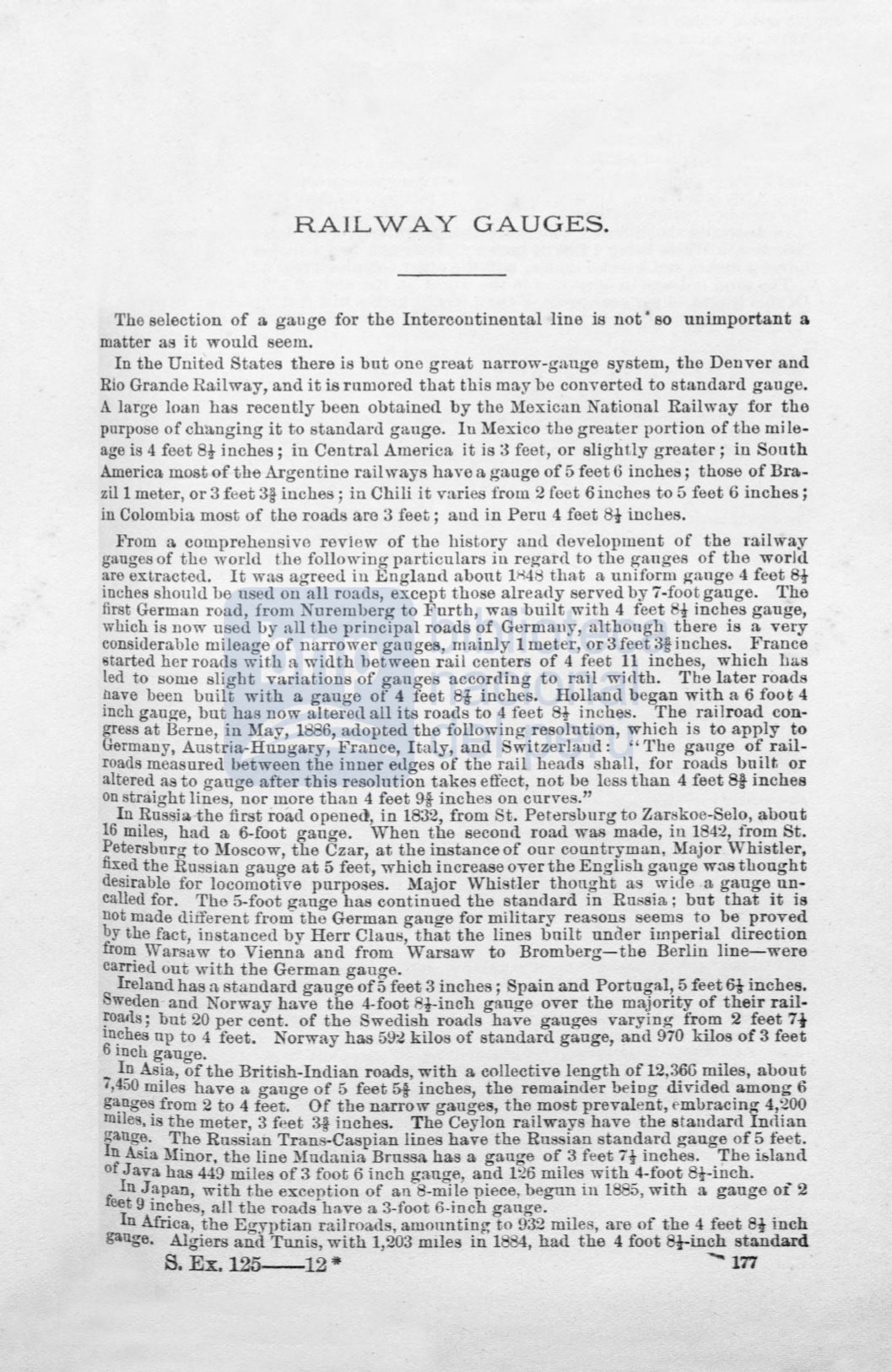

RAILWAY GAUGES.
The selection of a gauge for the Intercontinental line is uot ·so unimportant a
matter as it would seem.
In the United States there is but one great narrow-gauge system, the Denver and
Río Grande Railway, and it is rnmored that this ma.y be converted to standard gauge.
A large loan has recently been obtained by the Mexican National Railway for the
parpose of chttnging it to standard ga.uge. In Mexico the greater portiou of the mi le–
age is 4 feet 8t inches; in Central America it is 3 feet., or slightly greater; in South
America most of the Argentina raíl ways have a gange of 5 feet 6 inches; those of Bra–
zill meter, or 3 feet 3¡ inches; in Chili it varíes from 2 feet 6 inches to 5 feet 6 inches;
in Colombia most of the roads are 3 feet; and in Peru 4 feet
8t
inches.
From a comprehensive review of the history and development of the railway
gauges of the world
t
he following particulars in regard to the ganges of the world
are extractad.
It was agreed in England abont
1H4
that a uniform gange
4
feet
8t
inches should be used on all roads, except those already served by 7-foot gauge. The
first German road, from Nuremberg to Furth, was built with 4 feet 8t inches gauge,
which is now used by all the principal roads of Germany, althongh tbere is a very
considerable mileage of narrower ga uges, mainly 1 meter, or 3 feet 3! inches. France
started her roads with a width between raíl centers of 4 feet 11 inches, which has
led to sorne slight variations of gauges according to raíl wirlth. The later roads
~ave
been built with a gauge of 4 feet
8t
inches. Holland began with a 6 foot 4
mch gauge, but has now altered all its roads to 4 feet 8t inches. The railroad con–
gre s at Berne, in May, 1886, adopted the following resolution, which is to apply to
Germany, Austria-Hungary
1
France, Italy, and Switzerlaud: "The ga.uge of rail–
roads measured between the inner euges of the
mil
heads sball, for roads built. or
altered asto gauge after this resolution takes effect, not be less than 4 feet
8f
inches
on straight lines, nor more than 4 feet
9i
inches on curves."
In
Russia the first road opened, in 1832, from St. Pett3rslmrg to Zarskoe-Selo, about
16 miles, had a 6-foot ga.uge. Wheu the second roau was made, in
1842,
from St.
Petersburg to Moscow, the Czar, at tbe instance of our countryma.n, Major Whistler,
fix~d
the Russian gauge a t 5 feet, which increase over the English gauge was thought
destrable for locomotive purposes. Major Whistler thonght as wiúe a gauge un–
called for. The 5-foot gauge has continued the standard in Russia; but that it is
not made different from tbe German gauge for military rea ons seems to be proved
by
the fact, instanced by Herr Claus, that the linea bnilt under impedal direction
fro~
Warsaw to Vienna and from Warsaw to Bromberg-
the Berlín line- were
carned out with tbe German gauge.
Ireland has a standard gauge of 5 feet 3 inche ; Spain and Portugal, 5 feet
6¡
inches.
weden and Norway have the 4-foot 8t-inch g auge over the majority of their rail–
~oaO.s;
but 20 per cent. of the Swedish roads have gauge varyina from 2 feet
7t
1
6
n~hes
np to 4 feet. Norway has 59-2 kilos of standard gauge, and 970 kilos of 3 feet
Inch gauge.
In Asia, of the British-Indian roads, with a collective length of 12,366 mile , about
7 ,450 miles have a gauge of 5 feet
5i
incbes, the remainder being divided among 6
g~nge~
from 2 to 4 feet. Of the narrow gauges, the most prevalent, embracing 4,'200
mtle .Is the meter, 3 feet 3i incbes. The Ceylon railways have the standard Inilian
gana~.
The Russian Trans-Caspian lines ha.ve the Ru
ian standard gauge of 5 feet.
Inf Asta Minor, the line Muda.nia Brussa has a gauge of 3 feet 7t inches. The i.sland
0
Java has 449 miles of 3 foot 6 ineh gange, and 1· 6 mile with 4-foot
t-inch.
f¡
In
J~pau,
with tbe exception of an -mile piece, begun in 18 5, with a gauge oi 2
eet 9 ID?hes, all the roads have a 3-foot 6-inch gauge.
In Afnca, the Egyptian railroads, amonnting to 932 mile , are of the 4 feet 8t inch
gauge. Algiers and Tunis, with 1,203 miles in 1884, had the 4 foot Sj-inch standard
S. Ex. 125--12 •
--
177
















